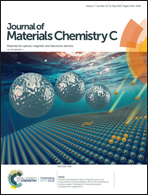A facile method to evaluate the influence of trap densities on perovskite solar cell performance†
Abstract
This work discusses how the behaviour of the fill factor (FF) of devices calculated from current–voltage (I–V) measurements at different light intensities can be used as a basis to assess the trap density of methylammonium lead triiodide (MAPbI3) solar cells. Solar cells with different trap densities are prepared using varying molar ratios of methylammonium iodide (MAI) and lead iodide (PbI2) precursors. Excess MAI in the precursor solution yields more traps/defects in perovskite films and when the trap density increases, trap-filling is the dominant loss mechanism, which results in a low FF in perovskite solar cells with excess MAI; this is especially the case at low light intensities. The FF of perovskite solar cells with excess MAI also shows a non-monotonic dependence on light intensity: the FF first increases, followed by a decrease with increasing light intensity. This non-monotonic dependence of the FF on light intensity suggests that both trap-filling and bimolecular recombination are involved in the determination of the FF in perovskite solar cells in cases where a high density of traps exists. Furthermore, we also observed that a stoichiometric precursor solution could lead to a monotonic light intensity-dependence for the FF in perovskite solar cells: the FF continuously decreases as the light intensity is increased from 1.7 to 100 mW cm−2. This monotonic dependence of the FF on light intensity implies that bimolecular recombination is the main reason for the loss in FF in perovskite solar cells when a low density of trap states exists. In addition, the peak light intensity (Ppeak), at which the FF shows the highest value, would shift to a smaller value when the amount of excess MAI in the precursor solution is decreased and it approaches the stoichiometric ratio of one. These results suggest that by looking at how the FF varies with light intensity we can deduce the contribution of traps in the performance of perovskite solar cells. This will help tremendously in focusing on areas for improvement for such solar cells.



 Please wait while we load your content...
Please wait while we load your content...